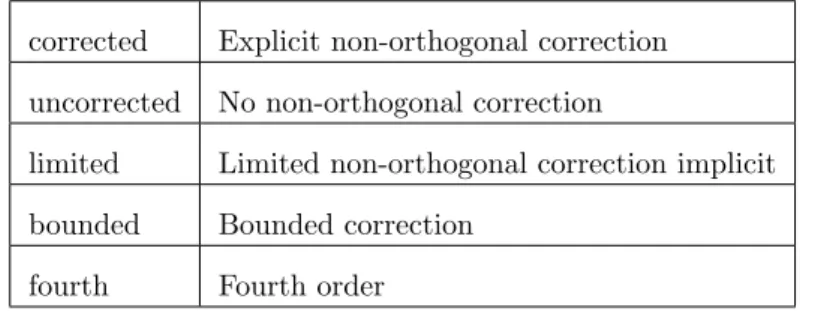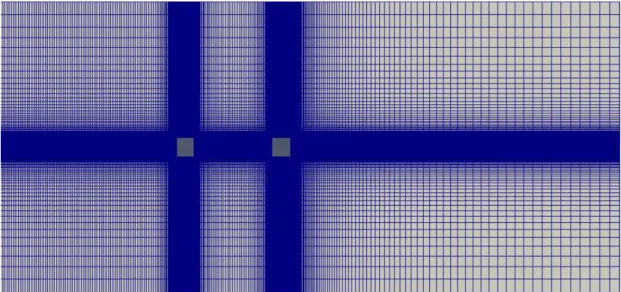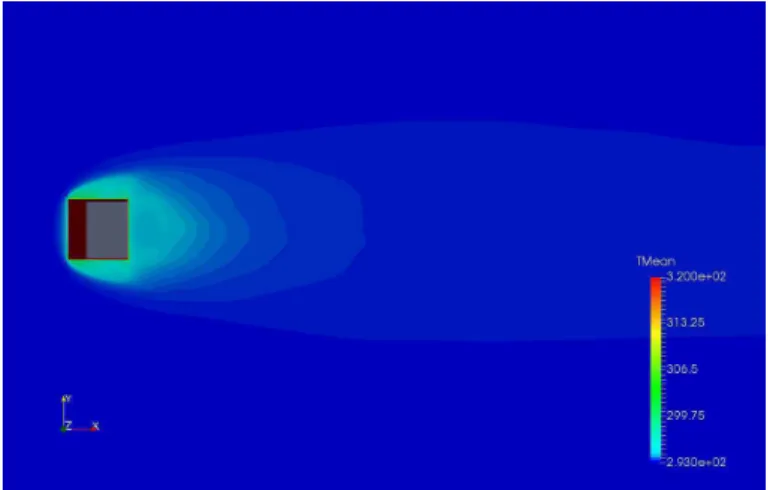The influence of the Reynolds number on the heat transfer characteristics is less pronounced in the second cylinder than in the first cylinder. The present results are in good agreement with available experimental correlations and results available in the literature. In the lower Reynolds number range, recent studies show that the flow field along with instability is complicated by three-dimensionality even in nominally two-dimensional geometries.
They can be placed in the wake of other bodies, resulting in either an increase or a decrease in their cooldown.
Flow over bluff bodies
Turbulence flow
Further confirmed by Karniadakis and Trianttafyllou [4] who showed that at a Reynolds number of 200, formation of secondary unstable structures in the two-dimensional vortex street leads to three-dimensional wake region. Bearman[5] observed the transition of flow from laminar to turbulent separation of the boundary for 2×105≤Re≤4×105 using hot wire probe in the wake region.
Flow over multiple bodies
Two circular cylinders of equal diameter, D, can be classified into three basic categories of possible arrangements based on the angle between the cylinders' central joining line. The distance is usually expressed as dimensionless longitudinal and transverse pitch ratios, L/D and T/D, respectively. The shear layers become longer than that of a single cylinder, the wake becomes narrower and vortex separation occurs at a higher Strouhal number. The reattachment region includes patterns B, C, D, E, E and G,[8].
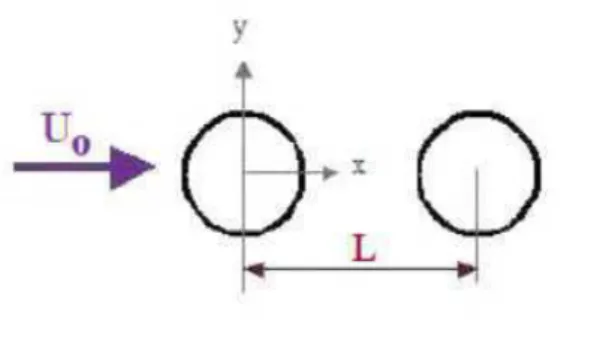
Flow over square cylinder
In pattern B, there is a synchronization of the reattachment of the upstream shear layer on the downstream cylinder and an eddy current from the other side of the downstream cylinder. In pattern C, quasi-stationary vortices are formed in the gap and reattachment is almost continuous. When the distance is increased, an intermittent eddy current from the upstream cylinder may occur in the orifice.
The vortices shed by the upstream cylinder collide with the downstream one and this causes the cylinder vortex to shed downstream. The difference between a bi-stable current and an unsteady current is that the picture of the flow as an unsteady flow lasts only for a very short time before changing, while that of a bi-stable current has a definite duration.
Literature survey
They observed the appearance of KH pairs in the separating shear layer on the side of the cylinder and confirmed the discontinuous nature of such a shear flow similar to the case of a round cylinder. These changes were associated with different flow patterns; namely, regular vortex shedding from the upstream cylinder was suppressed for L/d <4 and periodic vortex shedding from each of the cylinders started at a critical spacing of L/D = 4. When the cylinders were in tandem formation, the critical was found was that there is a spacing equal to about four times the length of the side D of the square cylinder.
The spacing between the centers of the cylinders varies from 1.5 to 9 widths of the cylinder and the Reynolds number varies from 2.0×103 to 1.6×104. The hysteresis is associated with two different flow patterns, and the discontinuity is attributed to a sudden change of the flow pattern. The sudden change in the flow patterns depended on the reattachment of the shear layer separated from the upstream cylinder.
At Re = 5300, the two separate shear layers at the two upstream corners of the upstream cylinder met at the front of the downstream cylinder. The top and bottom surface temperatures increase slightly as the roller spacing increases. This appears to be due to the transient nature of the square cylinder and the possibility (to be investigated) that this flow is much more sensitive to small changes in the control parameters.
Motivation
Wiesche[30] performed an LES study for a flow past a heated square cylinder, using two calculation grids for Re = 22,000. The LES method is a conventional method with the Smagorinsky eddy viscosity model, and the computational grid is small enough to be processed by workstations. The calculated turbulent flow field quantities are in good agreement with the experimental results reported by Lyn et al.
A reduced-dissipation scheme is demonstrated on a 2D square cylinder wake problem, showing a dramatic increase in accuracy for a given grid resolution. The results for simulations on three grids of increasing resolution for the 3D square cylinder weak are compared with experimental data and with other LES and DES studies. The comparisons of mean flow and global mean flow rates with experimental data are favorable, while the results for second order statistics in the wake are mixed and do not always improve with increasing spatial resolution.
Compressible LES on a hybrid mesh is used to predict the flow structure and the heat transfer at the wall. Flow past a heated single square cylinder is investigated using a hybrid LES-RANS approach on unstructured grids at a moderate Reynolds number of 22,050. Results of the LES-SST approach agree better with the experimental data especially at locations close to the cylinder surface and this leads to improved surface convective heat transfer compared to LES-SA[33].
Objectives of the present study
Thesis outline
Problem setup
Governing equations
Spalart-Allmaras DES
Boundary conditions
On the top wall of the domain, free stream temperature and horizontal velocity boundary conditions are applied. On the bottom wall of the domain, free stream temperature and horizontal velocity boundary conditions are applied. In the outlet of the channel, the fully developed flow boundary conditions are applied for both velocity and temperature fields.
Constant wall temperature and no sliding boundary conditions are used on the surfaces of the cylinder.
CFD Turbulence models
Reynolds Averaged Navier Stokes(RANS)
Large Eddy Simulation(LES)
Hybrid RANS / LES or Detached Eddy Simulation(DES) approach
This assumes that the production and destruction terms are dominant in an equilibrium flow (i.e. the diffusion term is negligible) and so they can be equated to form the Smagorinsky-like model. This new length scale acts as a sharp switching function between the RANS and LES approaches and depends on the grid resolution and the method used to calculate the filter width. Special care must be taken when designing the mesh on which a DES is to be performed [36] in order to ensure that the transition to LES occurs outside the boundary layer.
DES is not limited to use with the Spalart-Allmaras turbulence model and Strelet's formulated version, which uses the Menter SST turbulence model, cites its good performance in boundary layer calculations and separation prediction as why it would be an ideal candidate for RANS modeling in the near-wall region. Again, it is required that for an equilibrium free-stream ow, the k and ω transport equations are modified such that the turbulent viscosity of the Menter SST turbulence model reduces to a Smagorinsky-like form.
OpenFOAM
Constant Folder
For all solvers that compute the RANS equations, the RASProperties file specifies the turbulence model used. The type of turbulence model used is specified in TurbulenceProperties, where LES, RAS or laminar model can be selected. It also has another folder called PolyMesh where there are files that describe the mesh.
These files include points, which contain grid pages points, which contain cell pages. Also the boundaries are given in the file boundary, here the boundaries are given names and also what type they are, such as blank, wall or patch.
In OpenFOAM, the available linear solvers are preconditioned conjugate or bi-conjugate gradient solvers, smooth solvers, generalized geometric algebraic multi-grid (GAMG) solvers, and also diagonal solvers (for explicit systems). The conjugate gradient solvers can use the diagonal-incomplete LU (DILU for asymmetric systems), diagonal-incomplete Cholesky (DIC for symmetric systems), diagonal preconditioning and GAMG preconditioning. During relaxation of the sequential equations can be set in this file, and if SIMPLE or PISO algorithms are used, settings for these can also be specified.
Solution Methodology
Mesh details
The results given in the next chapter were obtained using kOmegaSSTDES for flow over consecutive square cylinders for various Reynolds numbers, spacings and cylinder sizes. The geometric and flow parameters of the square cylinders are: Cylinder side h = D, domain height H = 15D, domain lengthL = 32.5D. The grid independence test was done for three grids and grid size of 75000 was used to get all the results shown in 3.3.
The accuracy of numerical method of Hybrid RANS/LES is analyzed by taking a benchmark problem of single square cylinder and comparing the different Hybrid approaches with the available experimental results are shown. Second validation involving tandem cylinders is also done to check the accuracy for tandem cylinders. Study of tandem square cylinders for different Reynolds number, spacing, sizes and configurations of cylinders is done and the following results are shown.
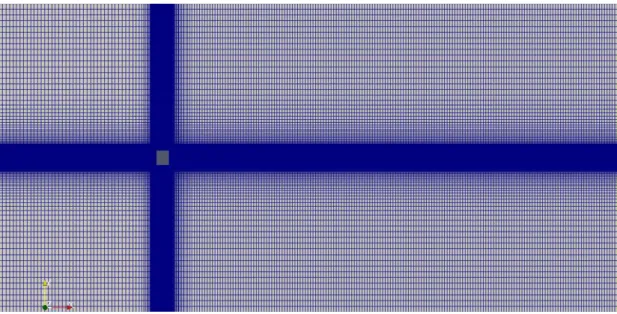
Validation of turbulent ow over single square cylinder
Error obtained by the komegaSSTDES model (2% error) is about 3% smaller than the error of the SplaratAllmaras-DES model (5% error) compared to Gnielinski correlation. It is decided to use the kOmegaSSTDES model to obtain results with flow over tandem cylinder configuration.
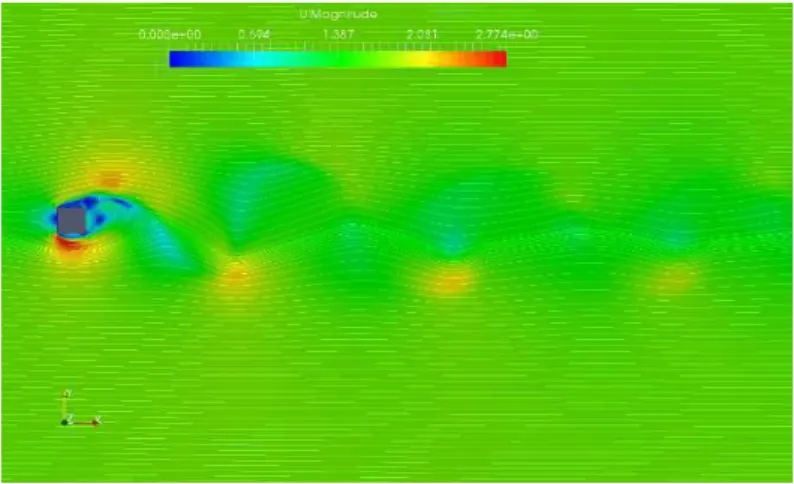
Validation and grid independence for flow over tandem square cylinderssquare cylinders
Grid independence
Effect of Reynolds number, spacings and sizes on heat transfertransfer
The Nusselt number for a cylinder with larger sides is higher for both downstream and upstream cylinders. The Nusselt number for the cylinders in the staggered configuration is lower for the down and up cylinders compared to the inline configuration. This work presents a DES of the flow and heat transfer in a tandem configuration of two square cylinders at moderate Reynolds numbers by varying the Reynolds number, spacings, sizes and configurations.
The Nusselt number for square tandem cylinders is 87.9 (at Re=16000,s=4D), which is found to be higher than that found for other spacings (N u <80) and configurations (N u75). This shows that heat transfer is higher when the distance between the cylinders is around the critical distance. The flapping shear layer formed by flow separation from the front corner of a square cylinder.
Coherent structures and their frequency signature in the separated shear layer on the sides of a square cylinder. Experimental and LES analysis of high-order flow in the ob-wall region of a square cylinder. Forced convection heat transfer from tandem square cylinders in crossflow at low Reynolds numbers.
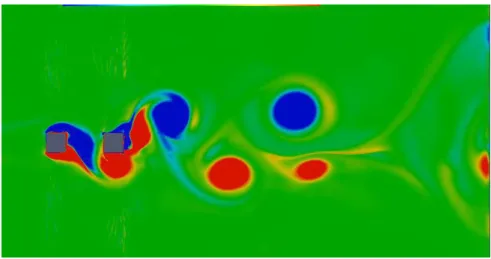
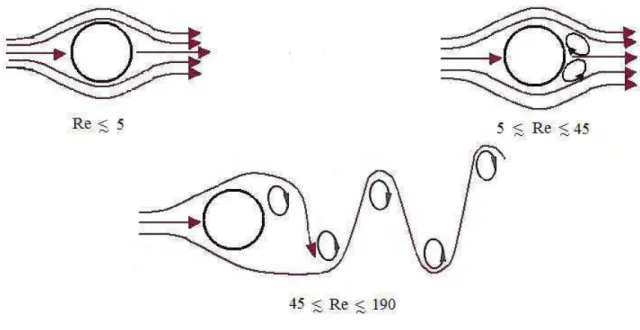
![Figure 1.3: Flow pattern for a circular cylinder in turbulent cross flow[2]](https://thumb-ap.123doks.com/thumbv2/azpdfnet/10473800.0/15.892.130.814.517.893/figure-flow-pattern-circular-cylinder-turbulent-cross-flow.webp)
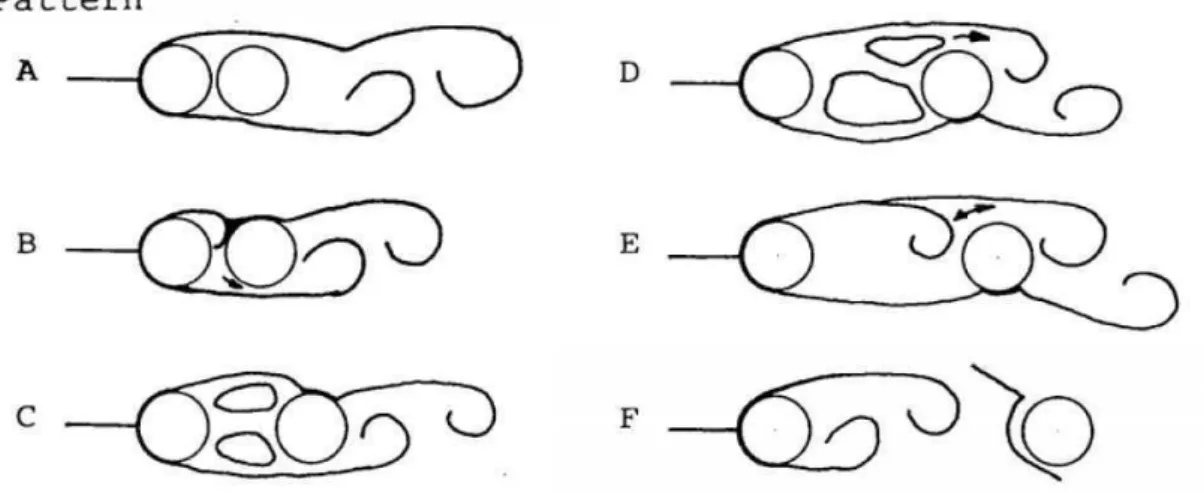
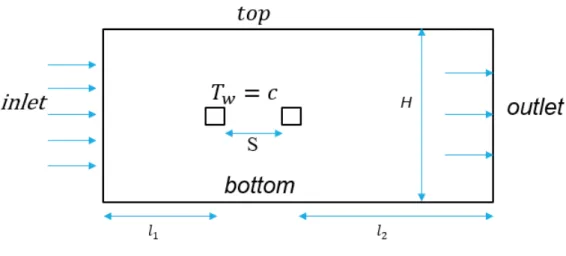
![Figure 3.1: Comparison between DNS, RANS, LES and Hybrid RANS/ LES approach.[35]](https://thumb-ap.123doks.com/thumbv2/azpdfnet/10473800.0/28.892.154.757.404.726/figure-comparison-dns-rans-les-hybrid-rans-approach.webp)
